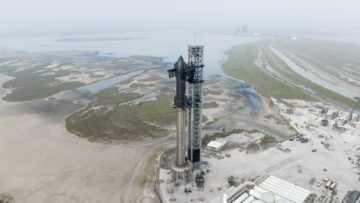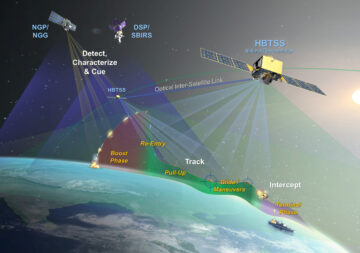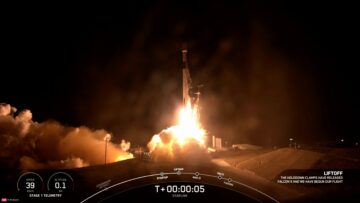
HELSINKI — China added to its series of Yunhai remote sensing satellites late Saturday with a launch from the Gobi Desert.
A Long March 2D rocket lifted off from Jiuquan Satellite Launch Center at 8:54 p.m. Eastern, Oct. 14 (0054 UTC, Oct. 15). The China Aerospace Science and Technology Corp. (CASC), confirmed launch success within an hour, also revealing the payload for the mission to be Yunhai-1 (04).
CASC’s Shanghai Academy of Spaceflight Technology provided the launcher for the mission and developed the Yunhai-1 (04) satellite.
Chinese state media describe the satellite as providing “services for the detection of the atmospheric, marine and space environments, disaster prevention and mitigation, and scientific experiments.” This is a generally used description of Yunhai spacecraft
The Yunhai series are assessed to be military meteorological satellites by some Western analysts.
China launched the first Yunhai satellite in November 2016. Yunhai-1 series satellites operate in roughly circular, 780-kilometer-altitude sun-synchronous orbits (SSO). The hypergolic Long March 2D has a launch capacity of 1,300 kilograms to a 700-kilometer SSO. Yunhai-2 series sats orbit with a similar altitude with inclinations of 50 degrees.
Yunhai-1 (02), launched in 2019, suffered a suspected collision with a small piece of debris from a Russian satellite launch in March 2021. U.S. Space Force cataloged a total of 37 fragments in orbit, with 23 having reentered the atmosphere to date.
Yunhai-1 (04) was China’s 47th orbital launch of 2023. CASC stated early in the year it would aim to launch more than 60 times, and has so far completed 33 launches. Commercial firms have contributed to the launch total.
China has suffered one failure so far in 2023, seeing the loss of a Jilin-1 remote sensing satellite aboard a commercial Ceres-1 rocket from Galactic Energy.
China is currently preparing for the launch of the Shenzhou-17 crewed mission. That launch will see a new, three-person crew head to the Tiangong space station later in the month. The Shenzhou-16 trio currently aboard the space station will handover Tiangong to the Shenzhou-17 crew for the start of their six-month-long stay in orbit.
The country is also working towards the launch of its Einstein Probe, a wide-field x-ray space observatory designed to detect flashes from cataclysmic cosmic events.
The spacecraft passed thermal vacuum and other tests across July and August. China plans to launch it in December from the Xichang Satellite Launch Center using a Long March 2C rocket.
- SEO Powered Content & PR Distribution. Get Amplified Today.
- PlatoData.Network Vertical Generative Ai. Empower Yourself. Access Here.
- PlatoAiStream. Web3 Intelligence. Knowledge Amplified. Access Here.
- PlatoESG. Carbon, CleanTech, Energy, Environment, Solar, Waste Management. Access Here.
- PlatoHealth. Biotech and Clinical Trials Intelligence. Access Here.
- Source: https://spacenews.com/china-launches-new-yunhai-remote-sensing-satellite/
- :has
- :is
- ][p
- 1
- 14
- 15%
- 2016
- 2019
- 2021
- 2023
- 23
- 2D
- 300
- 33
- 50
- 54
- 60
- 8
- a
- Academy
- across
- added
- Aerospace
- aim
- also
- an
- Analysts
- and
- ARE
- AS
- At
- Atmosphere
- atmospheric
- AUGUST
- BE
- by
- Capacity
- cataclysmic
- Center
- China
- China Aerospace
- Chinas
- commercial
- Completed
- content
- contributed
- Corp
- country
- crew
- Currently
- Date
- December
- describe
- description
- DESERT
- designed
- detect
- Detection
- developed
- disaster
- Early
- eastern
- einstein
- embedded
- energy
- environments
- events
- experiments
- far
- firms
- First
- For
- Force
- from
- generally
- Handover
- Have
- having
- head
- hour
- HTTPS
- in
- IT
- ITS
- jpg
- July
- Late
- later
- launch
- launched
- launches
- Lifted
- Long
- loss
- March
- Marine
- Media
- Military
- Mission
- mitigation
- Month
- more
- New
- November
- observatory
- Oct
- of
- off
- operate
- Orbit
- Other
- passed
- piece
- plans
- plato
- Plato Data Intelligence
- PlatoData
- preparing
- Prevention
- probe
- provided
- providing
- remote
- revealing
- rocket
- roughly
- russian
- s
- satellite
- satellites
- sats
- saturday
- Science
- Science and Technology
- scientific
- see
- seeing
- Series
- shanghai
- similar
- small
- So
- so Far
- some
- Space
- Space Force
- space station
- spacecraft
- spaceflight
- start
- State
- stated
- station
- stay
- success
- suffered
- suspected
- Technology
- tests
- than
- that
- The
- their
- thermal
- this
- to
- Total
- towards
- trio
- u.s.
- U.S. Space Force
- used
- using
- UTC
- Vacuum
- was
- Western
- will
- with
- within
- working
- would
- x-ray
- year
- youtube
- zephyrnet











